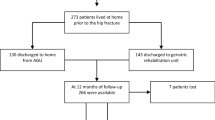Abstract
To prove the efficiency of a specialized geriatric ward (cognitive geriatric unit, CGU) for patients with a fracture of the proximal femur and additional dementia, we conducted a matched-pair analysis comparing 96 patients with fracture of the proximal femur and additional dementia matched for age, sex, surgical treatment and the degree of cognitive impairment by MMSE score. A total of 48 patients were treated in the CGU, offering extended geriatric assessment, special education of staff, and architecture appropriate for patients with cognitive decline. Target criteria were a gain in the Barthel index and Tinetti score, the length of stay, new admissions to nursing home, the frequency of neuroleptic, antidepressant, and antidementive medication, and the number of specified clinical diagnoses for the dementia syndrome. Length of stay was significantly longer in the CGU. The increase of the Tinetti score was significantly higher in the patients in the CGU, regardless of the length of stay (analysis of covariance: treatment (CGU/non-CGU): F(1/93) = 9.421, p = 0.003; covariate (length of stay): F(1/93) = 3.452, p = 0.066, η2 = 3.6%). In the intervention group, the number of definite diagnoses concerning the dementia syndrome was also higher. Comparison of drug treatment and the percentage of new admission to a nursing home did not differ between groups. Treatment in a specialized, “cognitive geriatric unit” seems to result in better mobility of demented patients with proximal fractures of the femur.
Zusammenfassung
Um die Effektivität einer Spezialstation („cognitive geriatric unit“, CGU) für kognitiv eingeschränkte Patienten mit zusätzlichen Akuterkrankungen zu überprüfen, untersuchten wir in einer Matched-Pair-Analyse 96 Patienten mit proximaler Femurfraktur und zusätzlicher Demenzerkrankung. Insgesamt 48 Patienten wurden in einer Spezialstation für „kognitive Geriatrie“ behandelt, die anderen 48 Patienten waren vor Gründung der Station in der gleichen Krankenhausabteilung behandelt worden. Die Patienten waren nach Alter, Geschlecht, Art der chirurgischen Vorbehandlung und dem Ergebnis des Mini-Mental-Status paarweise zusammengefasst. Die Behandlung in der Spezialstation umfasste u. a. ein erweitertes geriatrisches Assessment, spezielle Ausbildung der Mitarbeiter und architektonische Ausrichtung für Patienten mit kognitiven Einschränkungen. Untersucht wurden der Zuwachs im Barthel-Index und Tinetti-Mobilitätsscore, die Aufenthaltsdauer, Ziel der Entlassung, die Medikation und die Spezifität der Demenzdiagnosen. Die Aufenthaltsdauer auf der Spezialstation für kognitive Geriatrie war signifikant länger. Der Zuwachs im Tinetti-Score war in der Spezialstation signifikant größer als bei konventioneller Behandlung, unabhängig von der längeren Aufenthaltsdauer [Kovarianzanalyse: Behandlung (CGU/Nicht-CGU): F(1/93)=9,421, p =0,003; Kovariate (Aufenthaltsdauer): F(1/93)=3,452, p =0,066, η2 = 3,6%]. Auch die Anzahl der spezifizierten Demenzdiagnosen war in der Spezialabteilung größer. Die Behandlung von Patienten mit proximaler Femurfraktur und Demenz in einer Spezialeinheit für kognitiv eingeschränkte Patienten scheint mit einer zusätzlich verbesserten Mobilität einherzugehen.
Similar content being viewed by others
References
Rösler A, Hofmann W, Renteln-Kruse W von (2010) Special care units for the treatment of acutely ill, cognitively impaired geriatric patients in Germany. Z Gerontol Geriatr 43:249–253
Rösler A, Krause T, Niehuus C, Renteln-Kruse W von (2009) Dementia as a cofactor for geriatric rehabilitation-outcome in patients with osteosynthesis of the proximal femur: a retrospective, matched-pair analysis of 250 patients. Arch Gerontol Geriatr 49:e36–e39
Stevenson DG, Decker SL, Dwyer LL et al (2010) Antipsychotic and benzodiazepine use among nursing home residents: findings from the 2004 National Nursing Home Survey. Am J Geriatr Psychiatry 18:1078–1092
Weyerer S, Schäufele M, Hendlmeier I (2010) Evaluation of special and traditional dementia care in nursing homes: results from a cross-sectional study in Germany. Int J Geriatr Psychiatry 25:1159–1167
Zieschang T, Dutzi I, Müller E (2009) Improving care for patients with dementia hospitalized for acute somatic illness in a specialized care unit: a feasibility study. Int Psychogeriatr 22:139–146
Acknowledgments
The authors would like to thank the team on the ward for “Kognitive Geriatrie.”
Conflict of interest
The corresponding author states that there are no conflicts of interest.
Author information
Authors and Affiliations
Corresponding author
Rights and permissions
About this article
Cite this article
Rösler, A., von Renteln-Kruse, W., Mühlhan, C. et al. Treatment of dementia patients with fracture of the proximal femur in a specialized geriatric care unit compared to conventional geriatric care. Z Gerontol Geriat 45, 400–403 (2012). https://doi.org/10.1007/s00391-012-0299-1
Published:
Issue Date:
DOI: https://doi.org/10.1007/s00391-012-0299-1




